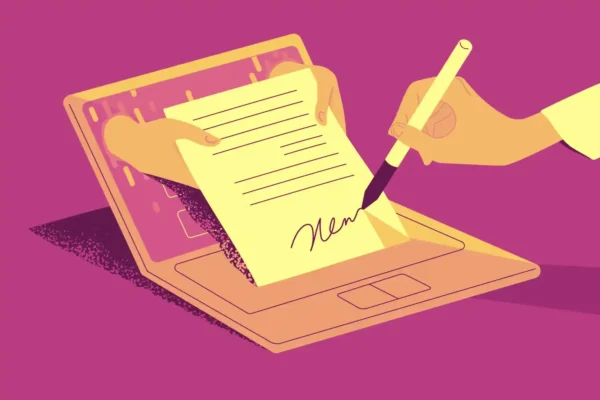
4 Ways to Thrive as a Freelance Graphic Designer
Two years ago, Karli Isiyel decided it was time to pursue her dream of becoming a freelance graphic designer. After nearly a decade leading the marketing department at Kerbey Lane Cafe in Austin, TX, Isiyel was ready to offer her unique blend of branding and graphic design skills to the rest of the Austin community.
Along the way, she faced many challenges. From self-generated leads to client-facing skills, Isiyel quickly learned that success as a freelance graphic designer goes far beyond the work itself. Here are the four biggest takeaways she offered for any graphic designer thinking about life as a full-time freelancer.
Build a Database of Future Clients
Like any full-time freelancer, Isiyel’s first clients were carried over from her time as an in-house graphic designer. “I did make a lot of partnerships and connections from my full-time job,” she admits. These anchor clients – the cornerstone of her initial freelance portfolio – gave her the confidence to go into business for herself.
But growing your client list goes well beyond your existing relationships. As she focused on expanding her portfolio, Isiyel found online job boards like Indeed to be an effective pipeline for freelance graphic design jobs. She also preemptively identified companies that might be a good fit for her skills.
“Austin Business Journal has a book of lists that they do every year, and it goes across every industry,” she explains. “That’s a really good resource to find companies that you might want to work with.”
Proactively seeking out business is not easy work, but there are ways to ease the burden on yourself. Rather than sink countless hours into building up a contact list, Isiyel decided to pay other freelancers to help her create a list of potential clients.
“I was looking for restaurant contacts,” she recalls, “so I was able to farm that out, to collect email addresses and have someone else scour the internet for those leads.” This approach allowed her to quickly grow her list of potential clients without costing her a lot of time or money.
Create the Perfect Case Study
When you work in the arena of visual design, your portfolio of design work often speaks for itself. What is sometimes less apparent is how you manage the scope of the project. To show potential customers her full design process – including the revisions and early drafts – Isiyel added a section for case studies on her website. This also allowed her to showcase ambitious projects from less recognizable organizations.
“If there’s something smaller but more meaningful to you, you can always do a case study,” Isiyel explains. “This is what I did on my website for projects that I really loved.” For her Built for Texas case study, Karli broke down the ultimate deliverable – Built for Texas’s Impact Report – into its component design goals, including behind-the-scenes photos of her work in progress.
What kind of things should you include in your case study? In a blog post on this very subject, stock photography provider Shutterstock recommends focusing on four key factors:
- Targeting. Your case study is meant to target future clients, so do not focus on a project or industry you are looking to walk away from in the future.
- Perspective. While you are sharing your success, your future client must be able to understand how they will benefit from your hard work.
- Narrative. Create a compelling story of why you and only you were the right person for the job.
- Data. Do your best to quantify the value your project added to the company. High-quality work is good, but high-performing outcomes are better.
For more advice on creating a graphic design portfolio geared towards potential business, be sure to read “An Expert’s Guide to Creating Graphic Design Case Studies” on Shutterstock’s website.
Sleep on Every Proposal
Knowing how to manage your workload is one of the trickiest things for any first-time freelancer to learn. At the beginning of her solo career, Isiyel approach every project as the right project. “When I left my job, I was like, ‘Anything and everything!’” she says with a laugh.
Soon, though, you may find yourself having to make tough decisions with your workload. Isiyel has found it helpful to break her monthly expenses – including bills and target savings goals – into hourly contracted work. If a new project does not help her meet those target goals, she has learned to be comfortable turning it down (while still leaving the door open for more work in the future).
Sometimes this is harder than others. “Very recently, I let go of one of my biggest clients I had since I quit my full-time job,” Isiyel explains. “The emotional energy that was going into it was not worth it.” This was intimidating for Isiyel, notably since this client provided her with a steady supply of projects and income.
However, even if you know that a project is not worth your time or energy, Isiyel recommends you give yourself a day before responding. “I try to wait at least 24 hours before I write back and say no,” Isiyel admits. In some cases, you may decide that the hourly rate is less important than the networking opportunities you earn from the client. Otherwise, there’s never any harm in letting potential clients feel like you’ve given their proposal your full consideration.
Set Clear Communication Expectations
For many graphic designers, your skill in a client-facing role will be determined by your most recent full-time work. If you come from the agency world, you may already be used to sitting down with clients and discussing multiple drafts of a project. If you come from an internal staff position, however, this may be a new experience for you.
“Developing systems for timelines, feedback, and approval for designs is really, really important,” Isiyel notes. “Agency experience could definitely lead into that. Otherwise, you may fumble along the way.”
Before you begin a new project, Isiyel recommends setting clear expectations on how and when feedback will be communicated. Some clients may want to interact entirely over the phone; others would prefer to use task management software or collaboration tools. “I like things in writing, especially for liability reasons.”
If you find yourself struggling to work in a client-facing role, this does not mean you aren’t cut out for freelance work. It just means you’ll need to budget extra time to over-communicate and over-listen to your clients’ demands. In an article on dealing with demanding clients, the team at Freelancer recommends developing your skills as an active listener and learning how to manage a personality disconnect.
Need a Better Bank for Your Business?
Open an Amplify Credit Union business checking account today.
